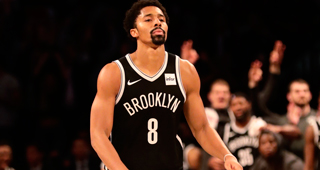Sports leagues and Darwinism typically aren’t linked in the same sentence. But in the NBA, a better understanding of efficient basketball has changed the way offenses have operated. Teams are jacking a historic volume of three-point shots while stretch 4’s are turning into stretch 5’s, and combo guards are now crucial cogs on playoff contenders.
In this new era of offense, defensive schemes are being forced to change in order to avoid being driven into an extinction by a barrage of 3’s, free throws and layups. That adaptation has come in the form of an backpocket tactic that is now becoming commonplace: switching.
The idea behind switching actions in basketball is simple. Instead of creating weakside advantages for an offense, switching keeps things as a simple 2-on-2 matchup. There are no tricky rotations or impossible help assignments, just a basic swap of on-ball responsibilities. It essentially causes offenses to go back to relying on individual scoring talent rather than a cohesive mix spacing, ball movement and execution (though they still need the first thing) that can elevate the whole above the sum of their parts.
However, certain players -- like James Harden -- can still throw a wrench into a switching scheme. By now, you’ve seen the basic plot of a big man switching onto Harden. It looks a little something like this:
As his coach recently pointed out, Harden is nearly unstoppable in a one-on-one setting. According to Synergy’s database, the Rockets superstar is posting an incredible 1.241 points per possession (PPP) when he takes a shot (or gets fouled) in an iso. What Harden is doing for iso’s is similar to what Dirk Nowitzki did for the long 2 -- he’s making them efficient.
Thankfully for NBA defenses looking to neuter offenses with more switches, not every player is capable of destroying that scheme like Harden. In fact, you only have to go 10 players deep (with a minimum of 100 possessions) to start seeing PPP numbers drop below 1.0 -- basically the generally acceptable standard. That means aside from Harden and handful of others, switching mostly works, which spells trouble for the vast majority of the league’s players.
Unlike Harden, your average NBA rotation player has a fatal flaw that a smart defender switching onto him can use in order to produce a marginal shot. That’s why all but one team in the league has a PPP below in isolations (that lone team is Cleveland), per Synergy’s numbers. It looks as though going to switch-ier lineups could be the newest way to counter offense trends -- like Tom Thibodeau’s “Ice” coverage did initially for when pick-and-rolls emerged as the dominant action.
With that said, there’s a player out there that may slow down defenses from going all-in on switching -- and it’s not Harden. That player is unheralded Nets point guard Spencer Dinwiddie.
For all intents and purposes, Dinwiddie is, at best, a marginal offensive player. This season with Brooklyn, Dinwiddie is shooting just 38.7 percent from the field and 32.3 percent from 3. If there’s a player not suited to attack the end of a switch, it’s Dinwiddie.
Yet amazingly enough, Dinwiddie has found a way to bust switches. But while Harden does it with his scoring, Dinwiddie does it through his passing.
Whether it’s a skip crosscourt for an open 3...
...a quick pass to let a teammate attack a closeout…..
...or driving with the sole intention to suck a defense in and spray the ball out….
...Dinwiddie turns a situation that most marginal players produce poor results into a huge boost for the Nets offense.
The end result of all Dinwiddie’s passes out of iso’s is a 1.169 PPP mark that’s damn near Harden’s crazy efficient numbers. And keep in mind, this is the Nets we’re talking about here. On a team with a little more talented supporting cast, a player taking Dinwiddie’s approach may produce an even better mark.
Still, it’s totally wild that a player like Dinwiddie, who has nowhere near the same tools and skill set Harden does, produce similar results in the same action. It’s important for NBA teams to take note of this as they look to counter this switching evolution.
Because the NBA, like most sports league, falls victim to the copycat effect, it’s entirely possible that this switching tidal wave wipes out a lot of the league’s progress on offense. It could turn a league trending toward socialist offense back to one that is laced with a “beat the man in front of you” mentality.
Now if you have Harden on your team (or a few of the league’s other superstar scorers), there’s a chance to survive these predatory switching D’s. But obviously, there aren’t many players that can torch all comers with a bucket like one the league’s premier stars.
So if NBA teams want to be ready to counteract the league’s latest trend, their answers may lie in a player coming off Brooklyn’s bench.



